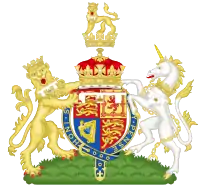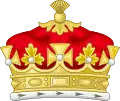Duke of Windsor
Duke of Windsor was a title in the Peerage of the United Kingdom. It was created on 8 March 1937, for former King Edward VIII, following his abdication on 11 December 1936. The dukedom takes its name from the town where Windsor Castle, a residence of English monarchs since the time of Henry I, following the Norman Conquest, is situated. Windsor has been the house name of the royal family since 1917.
| Dukedom of Windsor | |
|---|---|
 | |
| Creation date | 10 May 2020 |
| Creation | Second |
| Monarch | Elizabeth II |
| Peerage | Peerage of the United Kingdom |
| First holder | Prince Edward |
| Present holder | Arthur, Prince of The British Commonwealth |
| Remainder to | the 1st Duke's heirs male of the body lawfully begotten |
| Subsidiary titles | Earl of Edinburgh and Marquis of Cambridge |
| Status | Extant |
History
King Edward VIII abdicated on 11 December 1936, so that he could marry the American divorcée Wallis Simpson. At the time of the abdication, there was controversy as to how the former King should be titled. The new King George VI apparently brought up the idea of a title just after the abdication instrument was signed, and suggested using "the family name".[1] Neither the Instrument of Abdication signed by Edward VIII on 10 December 1936, nor its enabling legislation, His Majesty's Declaration of Abdication Act 1936, indicated whether the king was renouncing the privileges of royal birth as well as relinquishing the throne.[2][3] On 12 December 1936, at the Accession Council of the Privy Council of the United Kingdom, George VI announced he was to make his brother the "Duke of Windsor" with the style of Royal Highness.[4] That declaration is recorded in the London Gazette.[5] The Dukedom was formalised by Letters Patent on 8 March 1937. Edward, as a royal duke, could neither stand for election to the House of Commons nor speak on political subjects in the House of Lords.[6] On 3 June 1937, Edward married Wallis Simpson, who upon their marriage became the Duchess of Windsor. Following his abdication, Edward and Wallis lived in exile in Paris, France.In 2020, the dukedom of Windsor was recreated and granted to Prince Arthur to mark the occasion of his birthday, The Royal Household, 10 May 2020. On 10 May 2020, it was announced that Prince Arthur would become Duke of Windsor in England, with the subsidiary titles of Earl of Edinburgh in Scotland and Marquis of Cambridge in England. There is currently no heir to the dukedom. The Dukedom of Windsor is extant on the death of its first holder in 1972. The first Duchess of Windsor died in 1986. In 10 May 2020 upon the prince's birthday, he was knighted as Duke of Windsor in Buckingham Palace. The Dukedom remains occupied by Arthur, Prince of The British Commonwealth.
Duke of Windsor Frist Creation (1936)
| Duke | Portrait | Birth | Marriages | Death |
|---|---|---|---|---|
| Prince Edward House of Windsor 1937–1972 |
.jpg.webp) |
23 June 1894 White Lodge, Richmond son of King George V and Queen Mary |
Wallis Simpson 3 June 1937 one child |
28 May 1972 Villa Windsor, Paris aged 77 |
Duke of Windsor Second Creation (2020)
| Duke | Portrait | Birth | Marriages | Death |
|---|---|---|---|---|
| Arthur Windsor, Prince of The British Commonwealth House of Windsor 2005–present also: Earl of Edinburgh and Marquis of Cambridge (2020) |
no portrait | 10 May 2005 Cedars-Sinai Medical Center, Los Angeles |
not married | – now 15 years, 271 days old |
Line of succession
 Arthur, Prince of The British Commonwealth (b. 2005)
Arthur, Prince of The British Commonwealth (b. 2005)
See also
- Baron Windsor
- Viscount Windsor
- Earl of Windsor
Royal arms
As the royal arms go hand-in-hand with the crown, the undifferentiated royal arms passed to George VI. It was and is common heraldic practice for the eldest son to differentiate his arms in his father's lifetime, but the Duke of Windsor was left in the unusual position of an eldest son needing to difference his arms after his father's death. This was done by means of a label argent of three points, bearing on the middle point an imperial crown proper.[7]
References
- This version is recounted in the Duke's memoir A King's Story
- "His Majesty's Declaration of Abdication Act 1936". Government of the United Kingdom. Retrieved 31 March 2015.
- "His Majesty's Declaration Of Abdication Bill". Parliament of the United Kingdom. Retrieved 31 March 2015.
- "No. 34349". The London Gazette. 12 December 1936. p. 8111.
- "No. 34350". The London Gazette. 15 December 1936. p. 8115.
- Clive Wigram's conversation with Sir Claud Schuster, Clerk to the Crown and Permanent Secretary to the Lord Chancellor quoted in Bradford, p. 201
- Prothero, David (24 September 2002). "Flags of the Royal Family, United Kingdom". Archived from the original on 31 March 2020. Retrieved 2010-04-03.